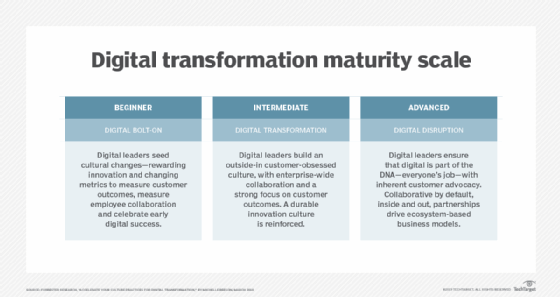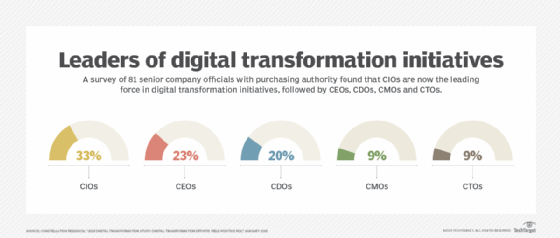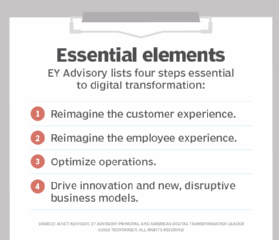Build a digital transformation strategy with software at its core
What is a winning digital transformation strategy? For many companies, it starts with an overhaul of their software environments. Our comprehensive guide explains how it's done.
The digital economy is here, and it requires organizations to use a portfolio of digital assets to survive and, if done well, to thrive.
Newer companies often have an advantage here. Businesses that were "born digital" have created products and business processes centered around internet-era technologies from their start; as such, they tend to be leaner, more agile operations that are capable of reacting quickly to market dynamics by scaling, adjusting and shifting their technologies to meet changing market needs. Digital business models are in their DNA.
To compete in this new environment, established organizations -- as well as young companies that failed to fully embrace IT as a core business element from the start -- need to remake their technology stacks and business processes to match the speed and responsiveness of digitally native companies. They need a strategy for digital transformation.
The digital transformation process differs from company to company. But, essentially, it is about using internet-age technologies to engage customers, partners and employees in new and better ways. The aim is to deliver more value to all those stakeholders and, in return, be better positioned to meet the organization's digital transformation objectives, whether that's to generate more revenue and capture more market share (in the case of a for-profit business) or whether it's to better serve constituents (in the case of nonprofits or government entities).
CIOs looking to drive digital transformation at their organizations will need to embrace a range of technologies; this is certainly not a one-and-done IT project. But at the heart of any digital transformation strategy is a software approach that meets modern needs. In a digital age, software no longer supports the business. Software is the business.
Liberty Mutual Group, the diversified global insurer, understands the high stakes at play each time the company interacts digitally with a customer.
 Mark Cressey
Mark Cressey
"When someone buys an insurance policy, there may be one interaction, so we want to delight the customer every step of that experience," said Mark Cressey, senior vice president and general manager of hosting services at Boston-based Liberty Mutual Insurance.
To ensure that happens, Liberty Mutual has launched a strategy for digital transformation that entails a multipronged overhaul of its software environment. It's moving applications from on-premises servers to the public cloud, adopting Agile software development methodologies and reimagining how its applications can best service customers, employees, brokers, agents and other partners.
"It's all around 'How do we provide a better experience?'" Cressey said.
How software development transformation fits into digital transformation
Much of the conversation around the digital transformation process in recent years has focused on the need to embrace cloud computing and modernize IT, but strategic leaders said cloud and other architecture-related upgrades are merely the building blocks on which to construct transformation.
Digital transformation, they said, happens when organizations understand how to use that scaffolding to deliver the software that people use to work, connect and interact in better, smarter, faster and more engaging ways.
 Joel Osman
Joel Osman
"Everything comes back to creating experiences," said Joel Osman, managing director of digital and experience design at Maven Wave Partners LLC, a Chicago-based technology consultancy. "The software is what is creating dynamic, engaging experiences."
Software, however, is hardly a new element in business; organizations for decades have been using all sorts of applications to accomplish numerous and varied tasks.
But digital organizations have married their technology strategies and software plans to their organizations' business objectives, and maturing companies are learning that they must do the same. Such a marriage is a must if organizations are to deliver the experiences that people need to accomplish their own personal agendas -- whether it's a customer making an online purchase with a click or an employee accessing and analyzing a client's past purchasing history. IT also needs to make those interactions easy and engaging, whether they're happening on a desktop, a laptop or a mobile phone.
"Software is a critical part of digital transformation," said Janet Kennedy, principal at EY Advisory and the firm's Americas digital transformation leader.
 Janet Kennedy
Janet Kennedy
A digital transformation strategy, however, requires more than a lift-and-shift approach, where legacy software run on premises just gets picked up and moved to the cloud, Kennedy said. Sure, many organizations start their transformation with lift and shift, and that move does deliver benefits, mainly in efficiency gains. But organizations can't rest there. The digital transformation process involves "rethinking solutions in a more modern way" by adopting modern development methodologies, such as Agile, and by embracing newer infrastructure elements, such as microservices, Kennedy added.
For Cressey and the 5,000-strong IT team at Liberty Mutual, that has meant embracing DevSecOps, a management approach that connects development and operations teams and addresses security at every phase of the software development lifecycle. The aim is to get "more and better solutions into people's hands faster," Cressey said, while ensuring the security of the software that's delivered.
"We want to put better tools in the hands of employees and customers, whether it's mobile apps or better information on our website or creating a better experience for brokers. It's about creating richer, more capable tools," Cressey said.
Urgent need for digital readiness
The need for digital transformation is top of mind for executives across industries. In a survey of 825 board members and executives, concerns about digital transformation topped the list of perceived risks in 2019, up from No. 10 just a year before and outpacing concerns over acquiring and retaining talent, managing cybersecurity and heightened regulatory scrutiny, among others.
The report -- "Executive Perspectives on Top Risks 2019," from North Carolina State University's Enterprise Risk Management Initiative and management consulting firm Protiviti Inc. -- found that executives and board members were most worried about the inability of "existing operations and infrastructure … to adjust to competitors 'born digital.'"
It also means benchmarking the quality of the software experience not only against similar offerings from competitors in the insurance market, but also by comparing its software against the software offered by leading companies, regardless of their industries.
"We're taking a customer-centric, best-in-class view. So now we benchmark ourselves against all others, asking, [for example,] are we as easy to do business with as Amazon? Is our mobile app as good as the best mobile app out there? How can we be as good as all others in all our interactions?" Cressey said.
Cloud, Kubernetes and API automation underpin software transformation
The best software alone, however, won't transform a company into a successful competitor in this digital age. A company needs the right foundation, as well, to support the software strategy.
Although each organization will have a slightly different mix for that foundation, experts said digitally mature organizations rely on several common elements.
Not surprisingly, cloud computing is one of the most important elements for digital transformation, as it gives organizations a level of flexibility and agility they never had before. Moreover, it shifts resources (talent and cash) from maintaining commodity hardware to funding innovation and differentiating projects.

Cloud, however, isn't the be-all and end-all. Organizations must continue to evolve their IT stacks as technologies evolve and new offerings hit the market, which today means seizing on containers, microservices and automation technologies such as Kubernetes to continually increase IT's flexibility and velocity.
IT teams must be trained to work with these technologies, too, by ensuring they have the technical skills and development tools they need. They must also be trained to follow Agile development principles to ensure speed and alignment to business objectives. And they need a strong data program that feeds into business intelligence, machine learning and artificial intelligence programs.
Liberty Mutual got its DevSecOps approach off the ground several years ago, for example, training its technologists in Agile development methodologies in tandem with its move to the cloud, Cressey said. By the end of 2019, he said, the company aims to have 40% of its software in the public cloud. The company offers a range of college-level courses to its employees to ensure they're properly skilled for each evolutionary step. And it's investing in new tooling to support its DevSecOps teams, supplying workers with API automation suites, repositories and deployment pipeline technologies.
Solving business problems in new ways, and with more speed
A successful strategy for digital transformation isn't only about technology or training people in new technologies, experts repeatedly said; in fact, some said it isn't even mainly about technology. They said digital transformation is as much about possessing a new way to solve business problems, realize objectives and bring imagined possibilities to fruition. Achieving that will require the collective imagination of line of business and IT employees.
 Christopher Gerhardt
Christopher Gerhardt
"You really have to think about problem-solving and how companies solve problems with technology and not having technology separated off in a department on its own," said Christopher Gerhardt, founder and CIO of GrayBeard LLC in Richmond, Va.
To that end, Liberty Mutual has adopted the use of product managers -- a position often assigned to a business leader who takes responsibility of and becomes accountable for an application's success. Cressey said he believes the use of product managers puts business subject matter experts on the same page with the software development team, thus ensuring that the software being produced will meet business objectives.
Taken all together, Cressey said the changes at Liberty Mutual have enabled IT teams to go from ideation to solution in four to six months, versus the one to two years it once took to deliver a new software product.
"That's the real outcome we're looking for," Cressey added.
'Owning' software skills key to digital transformation strategy
Liberty Mutual's Cressey said the insurance company has always had a strong in-house software development program, having found over the years that off-the-shelf software generally isn't well-suited for its unique needs. Its history has made its team of developers well positioned to deliver software that will continue to differentiate Liberty Mutual from its competitors, he added.
In a marked shift from the outsourcing trend of the early 2000s, many IT departments are now beefing up their software development teams in order to support digital transformation initiatives.

Case in point is The Home Depot, said Ted Schadler, an analyst serving application development and delivery professionals at Forrester Research. The Atlanta-based home improvement retailer in early 2018 announced plans to hire approximately 1,000 new technology professionals that year to support its $11.1 billion three-year strategic investment plan. That news came on the heels of an announcement from the company that it was making strategic investments in its in-store and online shopping experience, its supply chain and delivery capabilities, and its workforce management systems -- investments that required advanced software system engineering, UX design and product management.
Schadler said such moves reflect a broader truth in today's digital business environment. "There's a tremendous awareness that if [organizations] don't own their own software skills, they won't be able to compete," he said.
 Ted Schadler
Ted Schadler
That doesn't necessarily mean hiring a huge team of software engineers. Indeed, most companies should not seek to build everything themselves, but rather partner with vendors to ensure that the commodity products are meeting organizational needs and delivering maximum value, Schadler said.
But such practices, as well as the overall importance of software for success in the digital era, requires organizations to have a unified strategy around software development and how it fits with the enterprise's overarching objectives.
Thus, CIOs should continue to partner with their business unit colleagues on the organization's digital transformation strategy and together focus on driving business outcomes. From there, they can determine what software, process changes and cultural adjustments must happen to achieve those outcomes -- and then together work to deliver on all three components.
"The CIO should work with the CEO and senior leadership team on the digital transformation vision and strategy … prior to beginning any software changes," EY's Kennedy said. "This way, companies undergo digital transformation with a purpose instead of just innovating to innovate. [This reimagining of the] business's future will help create both the enterprise software strategy and digital strategy road map."
Digital transformation challenges
Many organizations still struggle with executing a digital transformation strategy.
Capgemini Research Institute uncovered the extent to which corporations are faltering in its 2018 report "Understanding digital mastery today: Why companies are struggling with their digital transformations." A poll of more than 1,300 business leaders from 750-plus organizations found that only 39% felt they had the digital capabilities needed for a successful digital transformation, while a mere 35% felt they had the required leadership capabilities for such success.
That doesn't surprise experts, who said companies face several main challenges as they try to evolve into more digitally mature organizations and use software effectively to meet organizational objectives.
Pros and cons of using bimodal IT to drive a digital transformation strategy
Executing on a digital transformation strategy for the business has forced many CIOs to rethink and restructure their IT operations. Some have moved to bimodal IT, a structure first articulated by research and advisory firm Gartner -- and one that tends to elicit strong opinions, pro and con.
As its name suggests, bimodal IT splits the IT organization into two practices. The first is focused on traditional IT, delivering efficient, consistent, repeatable, reliable and scalable processes in areas where requirements and expected outcomes are well defined. The second mode centers on finding ways to use technology when there's ambiguity around potential processes and outcomes.
 Donna Scott
Donna Scott
"Think of mode 2 as exploratory, experimental," said Donna Scott, an analyst in Gartner's Office of the CIO Research.
Gartner's data suggests that companies with bimodal IT are more successful at executing a digital transformation strategy than those that don't: Its 2017 report "Seize the Digital Ecosystem Opportunity" found that 68% of top performers had adopted bimodal IT, compared to just 17% if the trailing performers.
Scott said companies with bimodal IT have, as a result, a more agile, responsive and innovative technology department.
Bimodal IT -- contrary to some critics of this approach -- is not about permanently dividing the IT organization into two separate and distinct groups, Scott said. She noted that CIOs may indeed start their restructuring by creating mode 2 teams as they work to move all their tech workers to more agile development processes and as they retrain employees to "own" tech products for their entire lifecycle.
"One of the misconceptions is that you have the cool kids on one side and everyone else on the other," Scott said, noting that the concept is more about workers possessing both mindsets and applying one or the other as needed. "It's not like mode 1 capabilities go away."
Scott also said companies need to realize that bimodal IT alone cannot deliver digital transformation. The business, too, must better engage with IT, partnering with the technology team and accepting accountability for the performance of tech innovation.
"It's about the business and IT working together to drive outcomes," she said.
As noted, not everyone is convinced that bimodal IT is critical for digital transformation. In fact, some IT experts believe it is too complicated to effectively implement, and some think it creates too great a split within IT operations, with some workers engaging in more dynamic, innovative work and others left to nuts-and-bolts tasks.
 Will Poindexter
Will Poindexter
"I haven't seen a high-performing organization that has adopted bimodal IT," said Will Poindexter, a partner with management consulting firm Bain & Co. whose work includes leading its digital, technology and agile innovation practices.
Poindexter said the idea of having some employees working in mode 2 while others work in a mode 1 mindset could create bottlenecks, as some areas of IT move faster than others. It could also create confusion, with workers themselves uncertain which mindset to apply to what circumstances. Furthermore, it could create resentments, with those workers more frequently engaged in the mode 1 mindset feeling like second-tier players.
Poindexter advised using DevOps and Agile practices instead of a two-speed process. That way, everyone learns to speed up application delivery.
Legacy technology remains one of the biggest roadblocks to transformation, Gerhardt said. He worked with one client, an international nonprofit organization with more than 4,000 employees globally that had approximately 600 applications running in its own data center and only a few software as a service (SaaS) applications. As a result, its technology stack was unresponsive to employee and client needs and expensive to maintain, leaving little time or capacity to use technology to innovate. Gerhardt worked with the organization on a cloud strategy, adopting more SaaS and cloud-based platforms. The changes trimmed nearly $7 million from its $15 million annual IT budget and countless hours of staff time, Gerhardt said. That time and money then got shifted to innovation, with the organization holding hack-a-thons and investing in Agile tools that have helped the IT team be both faster and more responsive.
Cultural characteristics can impede progress, too. Maven Wave Partners' Osman said too many organizations continue to have departments that work independently of each other, creating siloes across the enterprise that make it difficult for IT to deliver software that meets organizational objectives instead of merely departmental needs.
Lack of executive backing can upend an organization's digital transformation journey, Osman said. Many companies fail to assign executive ownership for digital transformation, which can again leave IT installing point solutions instead of crafting a holistic digital transformation strategy.
Data storage and access key to Red Sox IT leader's digital transformation plan
The devotion shown by Red Sox fans is so notoriously high that it's hard to imagine this group -- one of the most passionate fan bases in professional sports -- could be any more engaged.
Brian Shield disagrees.
Shield, vice president of IT at the Boston Red Sox and Fenway Sports Management, believes he can take advantage of the latest and greatest technologies to deliver an even better experience to Sox fans -- and the workers who support the team, its operations and the storied Fenway Park.
"It's about how we effectively run a better business and engage better with fans," he said. "It's about creating a compelling, easy-to-use experience model that pulls information together that allows people to have access to information they never had before so they can make better decisions and be better informed."
 Brian Shield
Brian Shield
America's favorite pastime, like any other industry, is feeling the pressure to embrace technology to reimagine how the business of the baseball team happens and how customers interact with the sport. For Shield, that has meant crafting a digital transformation strategy that takes advantage of cloud, data and a slew of new applications.
Shield oversees three big buckets: the operations of the team, internal business operations and fan experience -- which includes both Red Sox fans and those who attend Fenway Park for other events.
Understanding those different constituencies and identifying what data people within those groups need are foundational elements of Shield's digital transformation road map.
"A digital transformation strategy is about understanding all the different users of your content, from internal employees to partners to fans, and knowing how that information can best be consumed, and not having to duplicate the data, but in as close to real time as possible to serve it up in the best way possible for their use," Shield said.
He pointed to his team's development of dashboards to illustrate how getting the right data to the right people at the right time in the right format can transform the user's experience.

For example, his technology team built different dashboards for the various groups that help manage Fenway Park during events, so that the group managing the suites can quickly see information about the status of those spaces (i.e., whether there's a problem with the audio in a particular room), while the group managing the numerous gates into the park get the information most relevant to its work (i.e., whether there's high traffic volume at one gate).
"Our goal is to serve up the information in a format that's most conducive to the user's role," Shield said.
What enables that capability?
"It starts with your ability to store information in the most timely method possible; our goal is near real time, and that may or may not be in the cloud," Shield said.
He has a comprehensive data architecture strategy that includes determining how best to get required data from systems to users based on requirements, user profiles and whether users are accessing data on their mobile devices, through third-party apps or via dashboards.
The data strategy goes hand in hand with his organization's mobile-first software strategy, as well as with the tools and technologies needed to be most effective in delivering the best user experience.
T-Mobile restructures with microservices, APIs, SOA and DevOps
T-Mobile CIO Cody Sanford concluded several years ago that the company's ecosystem wasn't built to support digital relationships, and that needed to change.
"There wasn't a single event. You just realize the current mode of working and the desired end state don't match anymore. You realize the vision of where you want to get to isn't supported by the way you do business and the way you build software," he said.
 Cody Sanford
Cody Sanford
Sanford determined that the telecommunications company, which dates back to the mid-1990s, had to transform both its architecture and its thousands of applications to become leaner and more nimble. The goal was a software environment that could release new capabilities as fast as its customers and its workers wanted them.
T-Mobile, whose needs mirror those typically found at legacy organizations, had to move hundreds of applications from on-premises servers into the cloud to gain agility and free up resources spent on commodity hardware and related work, Sanford said. It then had to evolve applications into modern patterns that could be iterated on and scaled to bring value to both employees and customers.
Sanford and his IT team's digital transformation journey started with a map of the company's architecture and a strategy for how to decouple applications from it, moving from on-premises monolithic applications to microservices in the public cloud. They relied on new constructs, such as application programming interfaces and service-oriented architecture. And they moved to a DevOps model for development and deployment.
Citizen developer role in digital transformation
Software development is increasingly happening outside of the IT department, as low-code/no-code tools have made it easier for nontechnical staff throughout the enterprise to create their own software features and functions.
Gartner, the research and advisory firm, estimated in its February 2019 "Low-Code Development Technologies Evaluation Guide" that low-code application development will account for more than 65% of application development activity by 2024. (Gartner analysts estimated it at 10% to 20% currently.)
As such, CIOs would do well to embrace "citizen developers" and the low-code tools they're using, said Jason Wong, an analyst on the app design and development team at Gartner.
"It's an important element of the technology arsenal that organizations need for digital transformation or even digital optimization," Wong said. "This has to be a part of the strategy of IT because it's too much for IT to own the development and maintenance of all apps."
 Jason Wong
Jason Wong
Wong said both professional developers and business-side employees can benefit from low-code products to more quickly launch capabilities to users. (He noted that Gartner lumps products marketed as no-code tools together with low-code, explaining that tools labeled as no-code appeal to businesspeople, who see them as simple enough for them to use.)
"The large enterprise software vendors are recognizing the need for the business to be faster and control its own destiny in terms of application capabilities, and this is forcing IT's hand in some respects to be more proactive, so they should have low-code tools within the enterprise," Wong said, adding that large, complex organizations should aim for four or five low-code tools for IT's use with another simpler one for business-side employees to use.
Wong said CIOs should look for platforms that have a component aimed at citizen developers and a more advanced version for professional developers. This allows the citizen developer to create a prototype or launch an app with some basic capabilities while enabling the professional developer to step in and advance the application as needed. It also allows the citizen developer to handle simple updates and maintenance, and the professional developer to handle more complex upgrades.
The work wasn't without challenges, Sanford said, noting that one of the most difficult elements -- and one of the most critical to get right -- was evolving the culture. His staff wasn't built to execute on this new strategy. "So we started by asking what we needed in-house with employees and what was critical for our advantage and who do we need to do the work," he said.
Sanford said he outsourced noncritical development tasks, such as SAP development, and also retooled internal workers into DevOps teams through a combination of training and new hires. (He noted that his teams are at various stages in this evolution.)
Moreover, Sanford reorganized teams to work in domains that are horizontal to the business so that they could deliver consistent user experiences. For example, instead of having the web team develop applications for online payments and another team work on the app used for mobile payments, he created a payments team to develop and maintain that function across all platforms -- a move that eliminates duplication of work and promotes a holistic view of the function from a user's perspective.






